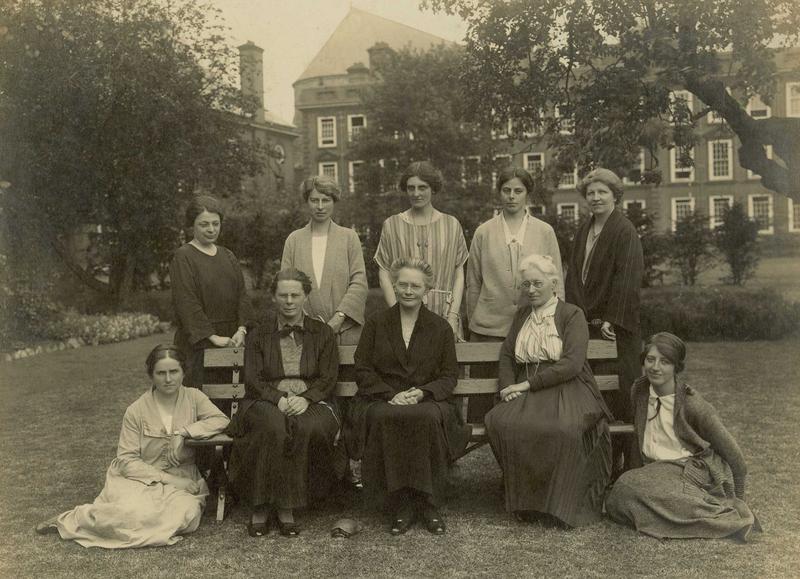Careers
Jane Robinson

A cartoon appeared in Punch in 1916, with the caption ‘The girl: what will she become?’1 The artist sketched some possibilities. An air-headed aficionado of fashion, perhaps, consumed by the thought of a new hat. The wizened landlady of an unappetising boarding-house. A masculine farm-girl, humping sacks of grain around or chopping down trees, or an imperious martinet with briefcase and cane, striding into her office at the bank (imagine!).
The joke was that everyone knew real women were designed for none of these things, despite the demands of so-called ‘modern girls’ for access to higher education and careers, and the temporary wartime displacement of working men by women on the home front. Their true destiny was motherhood. If that was unobtainable, they should embrace dignified and useful lives as maiden ladies, and stop pretending to be male.
Motherhood presupposed marriage. A survey of Cambridge alumnae compiled in 1895, reported that only 155 of Newnham’s 720 respondents had married (roughly 22%) and 45 of Girton’s 335 (13%).2 One assumes the statistics were broadly similar for the Oxford colleges. What were the rest to do? The only respectable profession for unmarried women before 1920 was teaching, which accounted for 52% of Newnham’s graduates and 37% of Girton’s. But because of the bar installed by local authorities forbidding the employment of married women, in place until 1944, the average working life of a teacher was just three years.3
A glance at the registers of women’s colleges in Oxford suggests that before 1920, besides marriage and teaching, alumnae worked in social welfare, charity administration, as missionaries, writers, and carers. Much of this work was voluntary. That last category is implicit in silence: it may be inferred from the lack of a specified occupation, that if a daughter returned to live at home after university, she fulfilled a domestic role within the family. One or two made it into the middle echelons of the Civil Service, but in these early days, that was rare.4
In 1913, St Hugh’s alumna Gwyneth Bebb (1889-1921) sued the Law Society for refusing to accept her as a trainee solicitor. She lost the case, and a subsequent appeal, on the Alice-in-Wonderland grounds that as no woman had entered the legal profession before, there was no precedent, and without a precedent, they could not be admitted. Besides, it had never been proven that women were ‘persons’ in a legal sense, and only people were eligible to become solicitors.5
The same Act of Parliament responsible for Oxford conferring degrees on women – the Sex Disqualification (Removal) Act (SDRA) of December, 1919 - was also the catalyst for women entering the six traditional professions, including law. Bebb applied again, this time to Lincoln’s Inn to read for the Bar, and was accepted. She was not the first to qualify: Dr Ivy Williams (1877-1966) of the Oxford Home Students has that distinction, though she never practised as a Barrister, preferring to return to her alma mater to teach.
It would be reasonable to suppose that the provisions of the SDRA were robust enough to fling open the creaky doors of the British Establishment and welcome women inside. Nowhere was this the case. They were allowed to study pre-clinical medicine at Oxford from 1917 onwards (late, compared with most British universities), but could only accomplish their clinical training at a handful of hospitals at home or abroad. Oxford pioneers include haematologist Dame Janet Vaughan (1899-1993), who went up to Somerville in 1919 and was elected principal in 1945, and her sister Somervillian and exact contemporary there, paediatrician Cicely Williams (1893-1992).
During the 1920s most London medical schools capped their intake of female medical students, or refused them altogether, not readmitting them until the end of the Second World War. Yet hundreds of women students and academics had worked during the war as surgeons, physicians, nurses and orderlies at home and abroad, acquitting themselves just as well as their male colleagues. No wonder the patriarchal medical profession was wary of enrolling them to practise alongside qualified men: they might poach all the patients.
Two sisters, also Somerville alumnae, were the first women to be elected associate members of the Royal Institute of British Architects (RIBA). Bessie (1869-1932) and Ethel Charles (1871-62) were forbidden to train at the Architectural Association’s school, however, because of their gender. They could only practice at all because a sympathetic male mentor took them on. Neither worked much after the First World War.
Plenty of female graduates were drafted into engineering workshops during the war, and excelled. But afterwards, few stayed on, deferring to returning servicemen. A number did open their own practices, however, especially in electrical or mechanical engineering.6 Oxford lagged behind Cambridge in teaching Engineering Science; the former’s department opened in 1875, the latter’s not until 1909. Cambridge’s first female engineer left the university before completing her tripos in 1912; Oxford’s graduated in 1939.7
Academia was an attractive career to graduates willing to invest their own learning in the next generations’. Fellows of the five women’s colleges tended initially to be drawn from a confined pool of candidates who combined academic expertise with a working knowledge of the way a college functions. It is interesting to note that in 1920, four of the five Heads of House were Oxford women. Emily Penrose of Somerville went up to the college in 1889 (aged 31) to read Greats; Eleanor Jourdain of St Hugh’s read Modern History at LMH; Winifred Moberly of St Hilda’s was also an alumna of LMH, while Bertha Johnson of the Oxford Home Students had been an officer of the Association for the Higher Education of Women since 1880. Only Henrietta Jex-Blake of LMH had no direct Oxford connection, though it is hard to think of a family more deeply steeped in academic tradition than hers.
One traditional profession remains: the Church. Here, too, we have pioneers. Maude Royden (1876-1956) read Modern History at LMH before becoming one of the most influential women preachers this country has ever known.8 Her friend Constance Coltman (née Todd, 1889-1969) also read history (at Somerville) before entering Mansfield College in 1913, to train for ministry in the Congregational church. She was ordained in 1917.
All of these career-women were remarkable, especially in the face of claims that it was futile to educate a woman likely to spend the rest of her life at home. This attitude is summed up in a withering ditty written by a male medical student in Ireland in 1902:
Though all the world’s a stage and we are acting,
Yet still I think your part is not dissecting.
To me the art of making apple tarts
Would suit you better than those ‘horrid parts’…
And a for learning Chemistry and that,
‘Twould be a nicer thing to trim a hat.
I know your aims in medicine are true,
But tell me, is there any need of you? 9
More than you know, my boy. More than you know.
[1] By F. H. Townsend, dated June, 1916 and accessible at https://www.punch.co.uk/embed/I0000DKyyeIF2Yiw?type=slideshow&G_ID=G0000seSmvU7.25Q&fallback=1 (retrieved April 2020).
[2] Alice M. Gordon, ‘The After-Careers of University-Educated Women’, Nineteenth Century, vol. 37 (1895), pp. 955-60.
[3] Elsie Lang, British Women in the Twentieth Century (London: T.W. Laurie, 1929).
[4] In fact the provisions of the SDRA specifically exempted the Civil Service from compliance.
[5] For an account of the proceedings and of the lives and work of pioneers in all the traditional professions, see Jane Robinson, Ladies Can’t Climb Ladders (Doubleday, 2020).
[6] The journal of the Women’s Engineering Society, The Woman Engineer, features hundreds of these people and is accessible online at https://www.theiet.org/publishing/library-archives/the-iet-archives/online-exhibitions/women-and-engineering/the-woman-engineer-journal/ (retrieved April 2020).
[7] Rachel Parsons (1859-1933) was the first woman to read Engineering at Cambridge; though she didn’t complete her degree she became a professional engineer and co-founded the Women’s Engineering Society in 1919. Oxford’s pioneer, Anne Pellew (1915-2001) of St Hugh’s, later worked on the design of Britain’s first jet bomber.
[8] Read Royden’s A Threefold Cord (London: Gollancz, 1947) for an insight into her extraordinary personal and professional life.
[9] St Stephen’s Catholic University Magazine, Dublin, 1902, p. 93; quoted in Laura Kelly, Irish Women in Medicine c. 1880s-1920s: Origins, Education and Careers (Manchester: Manchester University Press, 2012).





